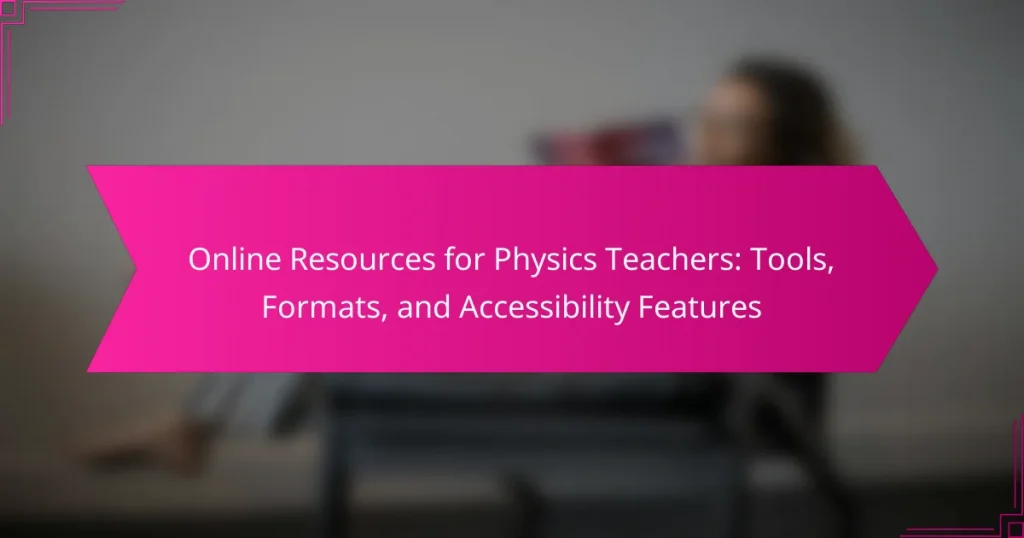Online resources for physics teachers encompass a variety of tools, platforms, and formats designed to enhance the teaching and learning of physics concepts. Key resources include simulation software like PhET Interactive Simulations, lesson plans from the American Association of Physics Teachers, and interactive platforms such as Google Classroom. These resources are available in multiple formats, including videos, interactive simulations, and e-books, each serving distinct educational purposes. Additionally, online forums and communities facilitate collaboration and idea sharing among educators. By effectively integrating these resources, physics teachers can improve student engagement and comprehension in their lessons.
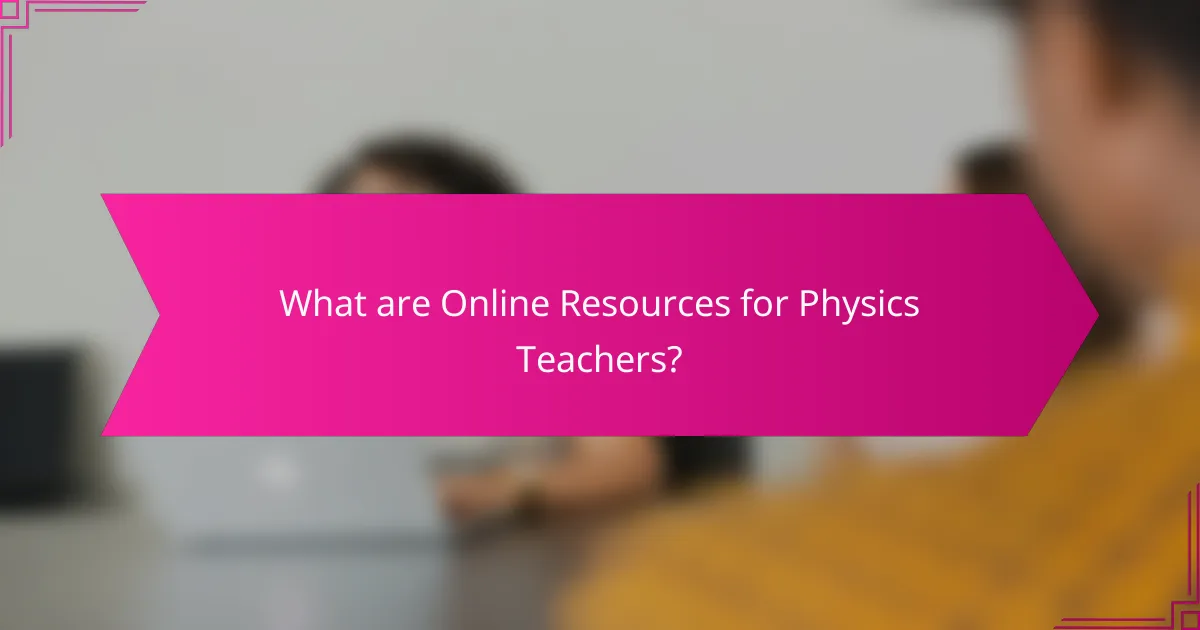
What are Online Resources for Physics Teachers?
Online resources for physics teachers include websites, platforms, and tools designed to enhance teaching and learning. These resources offer lesson plans, simulations, and interactive activities. Notable platforms include PhET Interactive Simulations, which provides free interactive math and science simulations. Another valuable resource is the American Association of Physics Teachers, which offers a wealth of teaching materials. The Physics Classroom is also a popular site that provides tutorials and practice problems. Additionally, online forums and communities, such as Physics Stack Exchange, allow teachers to share ideas and seek advice. These resources collectively support physics educators in delivering effective instruction.
How do Online Resources enhance Physics Education?
Online resources enhance physics education by providing accessible and diverse learning materials. These resources include interactive simulations, video lectures, and online textbooks. They cater to various learning styles, making complex concepts easier to understand. For instance, platforms like PhET offer interactive simulations that illustrate physics principles in real-time. Research shows that students using online simulations score higher in physics assessments. Additionally, online forums and discussion groups foster collaboration and peer learning. This accessibility allows students to learn at their own pace, reinforcing knowledge retention. Overall, online resources significantly improve engagement and comprehension in physics education.
What types of Online Resources are available for Physics Teachers?
Online resources for physics teachers include educational websites, video tutorials, interactive simulations, and online courses. Educational websites like Khan Academy and Physics Classroom offer structured lessons and practice problems. Video tutorials on platforms like YouTube provide visual explanations of complex concepts. Interactive simulations from PhET allow teachers to demonstrate physics principles in a virtual environment. Online courses from platforms such as Coursera and edX offer professional development and advanced topics in physics. These resources enhance teaching effectiveness and student engagement.
How do Online Resources facilitate collaborative learning in Physics?
Online resources facilitate collaborative learning in Physics by providing platforms for interaction and shared knowledge. These resources include forums, virtual labs, and collaborative tools. They enable students to work together on experiments and projects in real-time. For example, platforms like PhET Interactive Simulations allow students to explore physics concepts collaboratively. Research shows that students using online collaborative tools perform better in understanding complex concepts. A study by Dillenbourg (1999) emphasizes that collaborative learning enhances knowledge retention. Therefore, online resources significantly enhance collaborative learning experiences in Physics.
Why is Accessibility important in Online Resources for Physics Teachers?
Accessibility is important in online resources for physics teachers because it ensures that all educators and students can effectively engage with the material. Accessible resources accommodate diverse learning needs, including those of individuals with disabilities. According to the World Health Organization, approximately 15% of the global population lives with some form of disability. This statistic underscores the necessity for inclusive educational practices.
Accessible online resources also enhance learning outcomes by providing multiple formats and tools. For example, resources that include text-to-speech features or captions can support auditory and visual learners. Research from the National Center on Disability and Access to Education highlights that accessible materials lead to improved comprehension and retention.
Moreover, creating accessible content aligns with legal requirements, such as the Americans with Disabilities Act in the United States. Compliance with these regulations protects institutions from potential legal challenges. In summary, accessibility in online resources for physics teachers is vital for inclusivity, improved learning outcomes, and legal compliance.
What Accessibility Features should be included in Online Resources?
Online resources should include features like text-to-speech, alt text for images, and keyboard navigation. Text-to-speech enables users with visual impairments to access written content audibly. Alt text provides descriptions of images, ensuring visually impaired users understand visual information. Keyboard navigation allows users who cannot use a mouse to navigate the resource effectively. Other essential features include captions for videos and adjustable text size. Captions enhance comprehension for deaf or hard-of-hearing users. Adjustable text size accommodates users with visual difficulties, allowing them to read comfortably. Compliance with Web Content Accessibility Guidelines (WCAG) ensures these features meet established accessibility standards.
How do Accessibility Features benefit diverse learners in Physics?
Accessibility features benefit diverse learners in Physics by providing tailored support for various learning needs. These features include text-to-speech, which aids students with visual impairments. Closed captioning assists those with hearing difficulties. Customizable display settings help learners with dyslexia or attention disorders. Interactive simulations engage students with different learning styles. These tools enhance comprehension and retention of complex concepts. Research indicates that inclusive teaching methods improve overall student performance. A study by the National Center for Learning Disabilities found that accessibility features significantly enhance engagement and understanding among diverse learners.
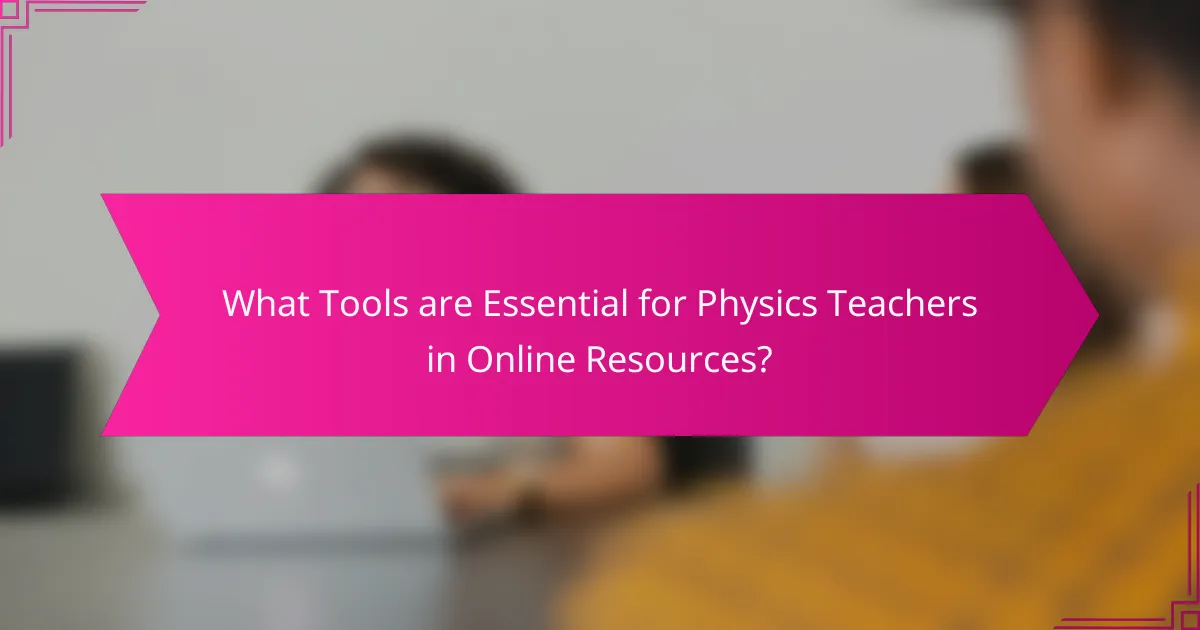
What Tools are Essential for Physics Teachers in Online Resources?
Essential tools for physics teachers in online resources include simulation software, virtual labs, and interactive platforms. Simulation software like PhET provides dynamic visualizations of physical concepts. Virtual labs allow students to conduct experiments in a digital environment, enhancing engagement. Interactive platforms, such as Google Classroom, facilitate communication and resource sharing. Online assessment tools enable teachers to evaluate student understanding effectively. Additionally, video conferencing tools support real-time instruction and collaboration. These tools collectively enhance the teaching and learning experience in physics education.
How can Interactive Simulations improve Physics teaching?
Interactive simulations can enhance physics teaching by providing immersive, hands-on learning experiences. They allow students to visualize complex concepts, such as motion and forces, in real-time. This visualization aids in understanding abstract principles that are often difficult to grasp through traditional methods. Research indicates that interactive simulations can increase student engagement and motivation. A study by the University of Illinois found that students using simulations scored 20% higher on assessments compared to those who learned through lectures alone. Additionally, simulations facilitate immediate feedback, enabling students to learn from mistakes in a safe environment. This iterative process reinforces learning and promotes deeper comprehension of physics topics.
What are the best platforms for Interactive Simulations in Physics?
PhET Interactive Simulations is one of the best platforms for interactive simulations in physics. It offers a wide range of simulations covering various physics concepts. These simulations are research-based and designed for effective learning. Another excellent platform is LabXchange, which provides virtual labs and interactive simulations. It allows users to explore physics concepts in a hands-on manner. Additionally, GeoGebra offers dynamic mathematics and physics simulations. It enables users to visualize and manipulate physics problems interactively. These platforms are widely used in educational settings for their engaging and informative content.
How do Interactive Simulations engage students in Physics concepts?
Interactive simulations engage students in Physics concepts by providing immersive, hands-on experiences. These simulations allow students to visualize complex phenomena. They can manipulate variables in real time. This interactivity fosters deeper understanding of abstract concepts. Research indicates that students using simulations perform better in assessments. A study by the University of Colorado found that interactive simulations increased student engagement and learning outcomes. By experimenting with different scenarios, students develop critical thinking skills. Overall, interactive simulations enhance conceptual comprehension in Physics education.
What Role do Assessment Tools play in Online Physics Resources?
Assessment tools in online physics resources evaluate student understanding and performance. They provide immediate feedback, enhancing the learning process. These tools often include quizzes, simulations, and interactive problems. They help identify knowledge gaps, allowing for targeted instruction. Assessment tools also track progress over time, offering insights into student development. Research shows that formative assessments improve learning outcomes in physics education. Effective assessment tools align with curricular standards, ensuring relevance to course objectives. Overall, they play a crucial role in facilitating effective teaching and learning in online physics resources.
How can Online Quizzes enhance student understanding in Physics?
Online quizzes can enhance student understanding in Physics by providing immediate feedback on their knowledge. This instant feedback helps students identify areas of weakness. Furthermore, quizzes promote active recall, which reinforces memory retention of key concepts. They can also facilitate self-paced learning, allowing students to revisit challenging topics. Research shows that frequent testing improves long-term retention of material. A study published in the journal “Science” found that students who engaged in regular quizzes performed better on final exams. Overall, online quizzes serve as an effective tool to deepen comprehension and retention in Physics.
What features make Assessment Tools effective for Physics teachers?
Effective assessment tools for physics teachers include clear alignment with learning objectives. They should provide immediate feedback to students, facilitating timely understanding of concepts. Customizability allows teachers to adapt assessments to different learning styles. Interactive elements, such as simulations, engage students and enhance comprehension. Data analytics features help teachers track student progress and identify areas needing improvement. Accessibility options ensure that all students can participate, regardless of their needs. Research indicates that tools integrating these features lead to improved student performance and engagement in physics education.
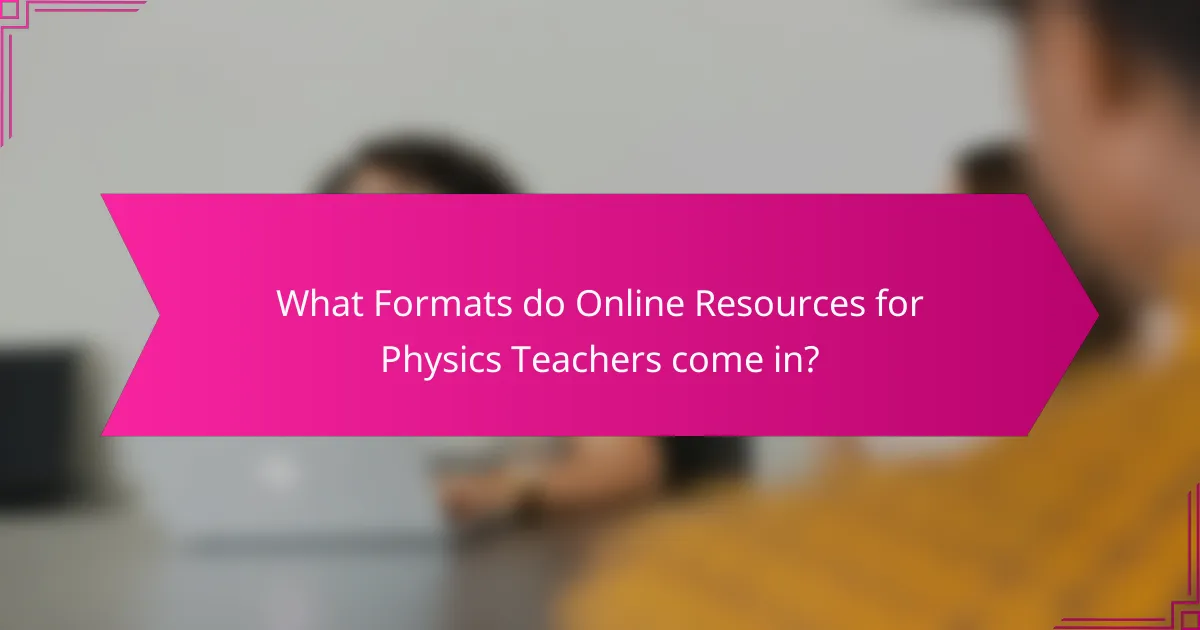
What Formats do Online Resources for Physics Teachers come in?
Online resources for physics teachers come in various formats. These include videos, interactive simulations, lesson plans, and e-books. Videos often provide visual explanations of complex concepts. Interactive simulations allow students to experiment in a virtual environment. Lesson plans offer structured guidance for teaching specific topics. E-books provide comprehensive content that can be easily accessed. Additionally, online forums and discussion boards facilitate collaboration among educators. Each format serves distinct educational purposes, enhancing the teaching and learning experience.
How do Video Lectures contribute to Physics learning?
Video lectures enhance Physics learning by providing visual and auditory explanations of complex concepts. They allow students to learn at their own pace. Students can pause, rewind, and replay sections for better comprehension. This flexibility accommodates diverse learning styles. Research shows that multimedia learning can improve retention rates. A study by Mayer (2009) indicates that students learn better with visual aids. Video lectures also foster engagement through interactive elements. They can include quizzes and discussion prompts to reinforce understanding. Overall, video lectures are effective tools for facilitating Physics education.
What are the benefits of using Video Lectures in Physics education?
Video lectures enhance Physics education by providing flexible learning opportunities. They allow students to learn at their own pace. This flexibility accommodates diverse learning styles. Video lectures can clarify complex concepts through visual aids and demonstrations. They often include animations that illustrate physical phenomena effectively. Research shows that students retain information better when engaging with multimedia content. A study by the University of California found that video lectures improved student performance by 15%. Additionally, video lectures can be accessed anytime and anywhere, promoting continuous learning. This accessibility supports students who may struggle with traditional classroom settings.
How can Video Lectures be effectively integrated into lesson plans?
Video lectures can be effectively integrated into lesson plans by aligning them with learning objectives. Teachers should select videos that complement the curriculum and address specific topics. Incorporating interactive elements, such as quizzes or discussions, enhances engagement and retention. Scheduling video lectures as pre-class assignments allows for in-depth classroom discussions. Additionally, providing guided notes can help students focus on key concepts during the lecture. Research shows that multimedia resources improve understanding and retention in physics education. A study by Mayer (2009) found that students who used video lectures performed better on assessments than those who did not. Therefore, thoughtful integration of video lectures can significantly enhance the learning experience.
What are the advantages of using Interactive eBooks for Physics?
Interactive eBooks for Physics offer several advantages. They provide engaging multimedia content, enhancing comprehension of complex concepts. Interactive elements, such as simulations and quizzes, promote active learning. This format allows for immediate feedback, helping students identify and address misconceptions. Additionally, interactive eBooks are easily accessible on various devices, increasing learning flexibility. They can be updated regularly, ensuring that students have access to the latest information. Research shows that interactive learning tools improve retention rates and student performance in STEM subjects. Overall, these features make interactive eBooks a valuable resource for teaching Physics effectively.
How do Interactive eBooks support different learning styles in Physics?
Interactive eBooks support different learning styles in Physics by providing diverse multimedia content. They offer visual elements like diagrams and simulations, which aid visual learners. Auditory learners benefit from integrated audio explanations and narrations. Kinesthetic learners engage through interactive simulations and hands-on activities embedded within the eBook.
Research shows that multimedia learning can enhance understanding and retention of complex concepts. A study by Mayer (2001) highlights that combining visual and auditory information improves learning outcomes. Thus, interactive eBooks cater to varied preferences, making Physics more accessible and engaging for all students.
What features should be included in Interactive eBooks for Physics?
Interactive eBooks for Physics should include multimedia elements, interactive simulations, and quizzes. Multimedia elements enhance learning by providing videos and animations that illustrate complex concepts. Interactive simulations allow students to manipulate variables and observe outcomes in real-time. Quizzes offer immediate feedback, reinforcing understanding and retention of material. Additionally, annotation tools enable students to highlight and take notes directly within the eBook. Accessibility features, such as text-to-speech and adjustable font sizes, ensure inclusivity for all learners. These features collectively create an engaging and effective learning experience for physics students.
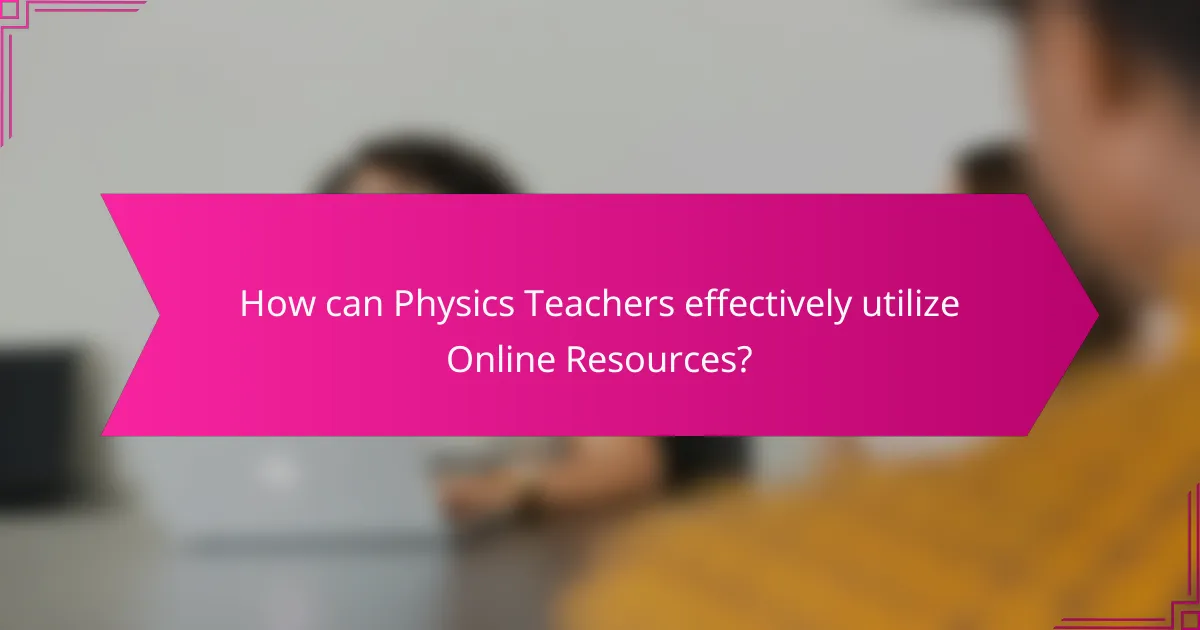
How can Physics Teachers effectively utilize Online Resources?
Physics teachers can effectively utilize online resources by integrating multimedia tools and interactive platforms into their lessons. These resources include videos, simulations, and virtual labs that enhance understanding of complex concepts. For instance, platforms like PhET provide interactive simulations that allow students to visualize physics phenomena. Additionally, teachers can use online forums and discussion boards to foster collaboration among students. Resources such as Khan Academy offer structured lessons and practice exercises aligned with physics curricula. Utilizing these tools can improve student engagement and comprehension. Studies indicate that interactive learning environments increase retention rates in science education. Therefore, incorporating diverse online resources is essential for modern physics teaching.
What strategies can Physics Teachers employ to select appropriate Online Resources?
Physics teachers can employ several strategies to select appropriate online resources. First, they should evaluate the credibility of the source. Trusted educational websites and peer-reviewed journals often provide reliable content. Next, they should assess the alignment of resources with curriculum standards. Resources that meet specific learning objectives enhance educational effectiveness.
Additionally, teachers should consider the accessibility of resources. Tools that accommodate diverse learning needs are essential for inclusivity. They should also review the interactivity of the resources. Interactive content can engage students more effectively than static materials.
Furthermore, teachers can seek feedback from colleagues. Peer recommendations can highlight valuable resources. Finally, they should stay updated with emerging technologies. New tools can offer innovative ways to present physics concepts.
How can Physics Teachers assess the quality of Online Resources?
Physics teachers can assess the quality of online resources by evaluating credibility, relevance, and usability. They should check the author’s qualifications and the publication’s reputation. Resources from established educational institutions or peer-reviewed journals are often more reliable. Teachers should also ensure that the content aligns with current physics curricula and learning objectives. Usability is crucial; resources should be easy to navigate and accessible to all students. Additionally, teachers can seek reviews or ratings from other educators to gauge effectiveness. Regularly updating resource lists based on feedback will help maintain quality.
What tips can enhance the use of Online Resources in Physics classrooms?
Incorporating interactive simulations can enhance the use of online resources in physics classrooms. These tools allow students to visualize complex concepts in real-time. For example, PhET Interactive Simulations provides various simulations that engage students actively. Utilizing video lectures can also be beneficial. They can clarify difficult topics and cater to different learning paces. Websites like Khan Academy offer high-quality physics content. Encouraging collaborative projects through online platforms fosters teamwork and deeper understanding. Tools such as Google Classroom facilitate communication and resource sharing among students. Regularly updating online resources keeps the material relevant and engaging. Finally, integrating quizzes and assessments can help track student progress effectively.
How can teachers encourage student engagement with Online Resources?
Teachers can encourage student engagement with online resources by integrating interactive content into lessons. Interactive tools like quizzes and simulations capture student interest. These resources allow students to actively participate rather than passively consume information. Research indicates that active learning strategies improve retention rates by 75% (Freeman et al., 2014). Additionally, teachers can facilitate discussions around online materials to promote critical thinking. Assigning collaborative projects using online resources fosters teamwork and deeper understanding. Providing timely feedback on student interactions with these resources enhances motivation. Lastly, incorporating gamification elements in online tools can make learning more enjoyable and engaging.
What common challenges do Physics Teachers face with Online Resources?
Physics teachers face several common challenges with online resources. One major issue is the overwhelming amount of information available. Teachers often struggle to identify high-quality, relevant resources among the vast options. Another challenge is the varying levels of digital literacy among students. Some students may find it difficult to navigate online platforms effectively. Additionally, the lack of interactive content can hinder engagement. Physics concepts often require visual aids and simulations for better understanding. Teachers also face issues related to technology access. Not all students have reliable internet or devices, creating disparities in learning opportunities. Finally, the alignment of online resources with curriculum standards can be problematic. Teachers must ensure that the resources they choose meet educational requirements.
Online resources for physics teachers encompass a variety of tools, formats, and accessibility features designed to enhance teaching and learning. This article provides an overview of essential online resources, including interactive simulations, video lectures, and assessment tools, highlighting their role in improving student engagement and comprehension. It also addresses the importance of accessibility in educational resources, detailing features that support diverse learners. Additionally, the article outlines strategies for selecting and effectively utilizing these resources in the classroom, while acknowledging common challenges faced by educators.
